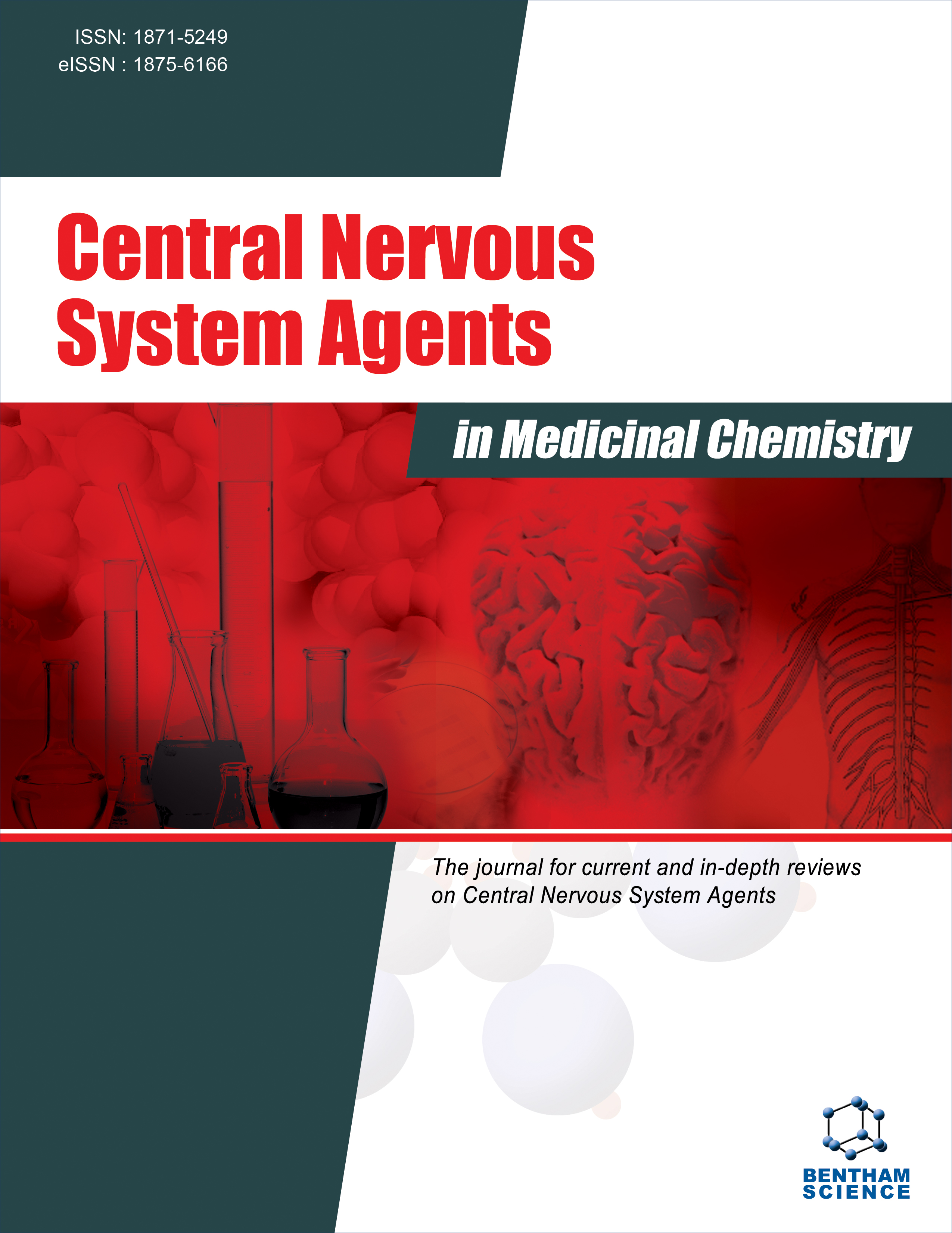- Home
- A-Z Publications
- Central Nervous System Agents in Medicinal Chemistry (Formerly Current Medicinal Chemistry - Central Nervous System Agents)
- Previous Issues
- Volume 9, Issue 2, 2009
Central Nervous System Agents in Medicinal Chemistry (Formerly Current Medicinal Chemistry - Central Nervous System Agents) - Volume 9, Issue 2, 2009
Volume 9, Issue 2, 2009
-
-
New Antiepileptic Drugs: Molecular Targets
More LessBy Marco MulaIn the past 20 years, a number of new antiepileptic drugs (AEDs) have been introduced and other molecules are in development, some of which are advantageous in terms of pharmacokinetics, tolerability and potential for drug interactions. These drugs are regarded as second generation compared to older agents such as barbiturates, phenytoin, carbamazepine, ethosuximide and valproic acid. Although some of these sec Read More
-
-
-
Estrogens as Potential Therapeutic Agents in Multiple Sclerosis
More LessAuthors: Masaaki Niino, Makoto Hirotani, Toshiyuki Fukazawa, Seiji Kikuchi and Hidenao SasakiThe disease activity of multiple sclerosis (MS) is known to be ameliorated during pregnancy, and pregnancy is also found to be protective in experimental autoimmune encephalomyelitis (EAE), an animal model of MS. Estrogen levels increase during pregnancy and basic researches have shown that estrogens have immunomodulatory effects on immune cells. The importance of estrogen in pathogenic autoimmune disease Read More
-
-
-
The Insulin-like Growth Factor-1 Axis and its Potential as a Therapeutic Target in Central Nervous System (CNS) Disorders
More LessAuthors: Olivia Bibollet-Bahena, Qiao-Ling Cui and Guillermina AlmazanThe insulin-like growth factor-1 (IGF-1) is a pleiotropic factor. Many studies have revealed its importance in the development and maintenance of the central nervous system (CNS). This review will discuss the IGF-1 axis, from the factor itself to the signalling pathways it activates, and its tight regulation. Particular focus will be brought on potential therapeutic targets of the IGF-1 axis in CNS disorders, including brain tumours an Read More
-
-
-
Endogenous Regulation of Neural Stem Cells in the Adult Mammalian Brain
More LessTissue-specific stem cells replenish organs by replacing cells lost due to tears and wears or injury throughout life. Long considered as an exception to this rule, the adult mammalian brain has consistently been found to possess stem cells that ensure neurogenesis. Neural stem cells persist within the subventricular zone bordering the lateral ventricles of the brain. Constitutively, neural stem cells proliferate and produce a continuo Read More
-
-
-
Biochemistry and Neurobiology of Prosaposin: A Potential Therapeutic Neuro-Effector
More LessProsaposin, a 66 kDa glycoprotein, was identified initially as the precursor of the sphingolipid activator proteins, saposins A-D, which are required for the enzymatic hydrolysis of certain sphingolipids by lysosomal hydrolases. While mature saposins are distributed to lysosomes, prosaposin exists in secretory body fluids and plasma membranes. In addition to its role as the precursor, prosaposin shows a variety of neurotrophic and Read More
-
-
-
Histamine H3-Receptor Inverse Agonists as Novel Antipsychotics
More LessBy Chihiro ItoSchizophrenia (SZ) that is resistant to treatment with dopamine (DA) D2 antagonists may involve changes other than those in the dopaminergic system. Recently, histamine (HA), which regulates arousal and cognitive functions, has been suggested to act as a neurotransmitter in the central nervous system. Four HA receptors-H1, H2, H3, and H4- have been identified. Our recent basic and clinical studies revealed that brain H Read More
-
-
-
Therapeutic Strategies in HTLV-I-Associated Myelopathy/Tropical Spastic Paraparesis (HAM/TSP)
More LessAuthors: Tatsufumi Nakamura, Yoshihiro Nishiura and Katsumi EguchiHuman T lymphotropic virus type I (HTLV-I)-associated myelopathy/tropical spastic paraparesis (HAM/TSP) is chronic progressive myelopathy characterized by bilateral pyramidal tracts involvement with sphincteric disturbances. HTLV-I infects approximately 10-20 million people worldwide. There are large endemic areas in southern Japan, the Caribbean, Central and South America, the Middle East, Melanesia, and equatorial Read More
-
-
-
The Trigeminal System in Birds and Nociception
More LessAim of this paper is to give a concise overview of what is known about the trigeminal nociceptive system in birds. Several types of nociceptors have been discovered, thermal nociceptors and polymodal, i.e. mechanothermal and mechanochemical receptors. Information from these receptors reaches the Laminae I and II of the caudal subnucleus of the descending trigeminal system and of the dorsal horn of the rostral spinal c Read More
-
Volumes & issues
-
Volume 25 (2025)
-
Volume 24 (2024)
-
Volume 23 (2023)
-
Volume 22 (2022)
-
Volume 21 (2021)
-
Volume 20 (2020)
-
Volume 19 (2019)
-
Volume 18 (2018)
-
Volume 17 (2017)
-
Volume 16 (2016)
-
Volume 15 (2015)
-
Volume 14 (2014)
-
Volume 13 (2013)
-
Volume 12 (2012)
-
Volume 11 (2011)
-
Volume 10 (2010)
-
Volume 9 (2009)
-
Volume 8 (2008)
-
Volume 7 (2007)
-
Volume 6 (2006)
Most Read This Month
Article
content/journals/cnsamc
Journal
10
5
false
en


